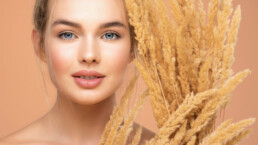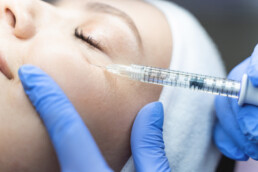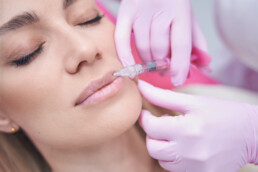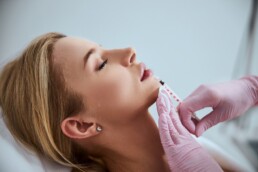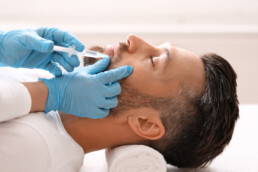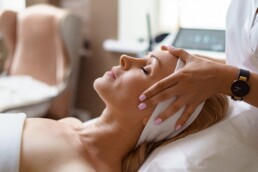Why Does Your Skin Break Out More In The Fall?
Tackling The Seasonal Breakouts
Almost all of us have dealt with acne at one point in our lives, some for longer than others. Did you know that acne is technically the eighth most common disease among all humans worldwide, even though it primarily affects adolescents and young adults?
The breakout season is upon us - some call it fall. Let's talk about the most common causes of seasonal breakouts and what you can do about your fall skin problems this year!
How Does A Breakout Even Happen?
Acne is caused by sebaceous glands near the surface of the skin, which secrete sebum. This is a complex group of oils that include triglycerides, fatty acid byproducts, wax esters, squalene, cholesterol, and cholesterol esters. These oils can block pores and hair follicles in the skin, leading to acne.
Essentially, breakouts occur because of increased oil production in the skin. This can be caused by imbalances in hormones, dry skin, or a few other factors.
Some people are more predisposed to experience breakouts than others, largely due to genetics. Still, when there is excess oil production on the skin, acne is quite likely.
Read More: The Best Facials For Every Skin Type
What Does Fall Have To Do With That?
In the fall months, your skin has become accustomed to humid air keeping your hair frizzy and your skin moist. While the frizz may finally subside in the fall, the dry air tends to suck moisture out of your skin. To compensate for this, your body may produce excess oil as a protective, moisturizing layer for your skin.
Unfortunately, this often leads to acne, especially in porous regions of your skin, like your face. Excess oil production can lead to clogged pores and breakouts quite quickly. Fortunately, there are ways to help alleviate and even prevent these breakouts!
How To Prevent Breakouts In Fall
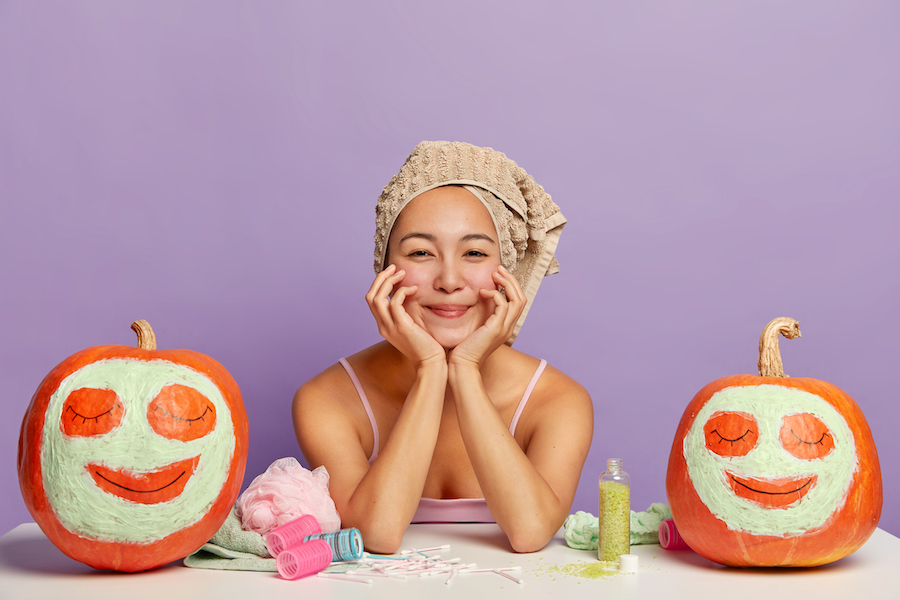
To prevent a skin breakout, you'll need to treat your dry, itchy skin in the fall before it's too late. Here are some tips that can help safely and naturally regulate your skin's oil production to prevent breakouts!
Clean Them Pores
Clogged pores are one of the most infamous causes of acne out there, and they're so simple to take care of! There are plenty of products you can use to try to scrub them, or you can simply use your thoroughly-washed fingernails.
The best way to do this is with hot water, whether in the shower or in front of the bathroom mirror. Hot water and steam help open your pores, making them easier to clean. Just remember to follow up with an oil-free moisturizer afterward, or else excess oil production will continue.
Stop Touching Your Face
The oil production in our faces is bad enough, but when combined with the dirt, debris, and oils on our hands, it will only worsen breakouts. Take note of how often you touch your face and try to reduce the number of times throughout the day. Don't worry, this is difficult to start, but it gets easier.
Did you know that the average person touches their face 23 times per hour? That's more than once every three minutes throughout the day! Taking steps to reduce this can go a long way toward preventing breakouts.
Read More: Five Most Common Skincare Problems
Change Pillowcase Often
Would you wear the same shirt for 8 hours a day, every day, for weeks without washing it? Would you wear a hat on your head and then rub it on your face every day? Well, that's essentially what you're doing with your pillowcase.
The oils from our faces are one concern, but we can't forget about our hair. Our heads move around on our pillows for at least 8 hours a night (hopefully!), trapping oils on a surface your face is touching daily. To remedy this, simply change your pillowcase every few nights and wash them with your regular laundry!
Beauty Sleep Is A Must
Sleep is essential for your overall health, but it's especially important for regulating hormones and oil production. For the best sleep, we recommend turning off your electronic devices at least an hour before bedtime. Calming music is okay, but staring at bright, blue-light screens before bedtime is a known sleep disruptor.
Stay Hydrated
If you take away anything from these tips, let it be this. The best solution to pollution is dilution. When your body is polluted with toxins, oils, and other acne-inducing issues, the best thing you can do is dilute it with water.
You don't have to carry around a gallon jug with you everywhere you go. However, be mindful of your water intake throughout the day, and don't let yourself feel thirsty at all. If it's been 45 minutes since you last drank water, have a few big sips, and make that a habit throughout the day.
Eat More Whole Foods
Unfortunately, many processed foods come loaded with processed sugars, enriched grains, and unhealthy fats. The more whole foods you eat throughout the day, the better. Did you know that the average teen in the US gets two-thirds of their calories from ultra-processed foods?
This trend is terrible for overall health and is likely a major culprit in your breakouts. Processed foods are known to cause imbalances in hormones and excess oil production.
Instead, opt for more whole, plant-based foods. These include vegetables, fruits, legumes, whole grains, quinoa, nuts, and seeds. Make foods you enjoy and try to make this a regular habit, even after the fall.
It gets a lot easier to make this transition when you make healthier variations of foods you enjoy. For example, if you love cereal, make overnight oats the night before. If you love pizza, make a cauliflower crust and load it with vegetables!
Keep Your Stress In Order
Stress is a known cause of acne. However, stress is a part of life for almost all of us. Fortunately, there are plenty of ways to deal with stress throughout the day.
You can try meditating, yoga, reading a book, or exercising. Exercise is a particularly effective stress reliever, as it helps balance hormones and alleviates our bodies' "fight or flight" responses from stress.
However, without proper hydration, exercise can speed up the process of unwanted toxins making their way onto our skin via sweat. Make sure you are properly hydrated before exercising, and feel free to take a shower afterward to prevent worsening breakouts.
Regardless of your preferences, find time during the day to work on relieving stress. This will improve your overall quality of life, as well as your skin.
Use These Products
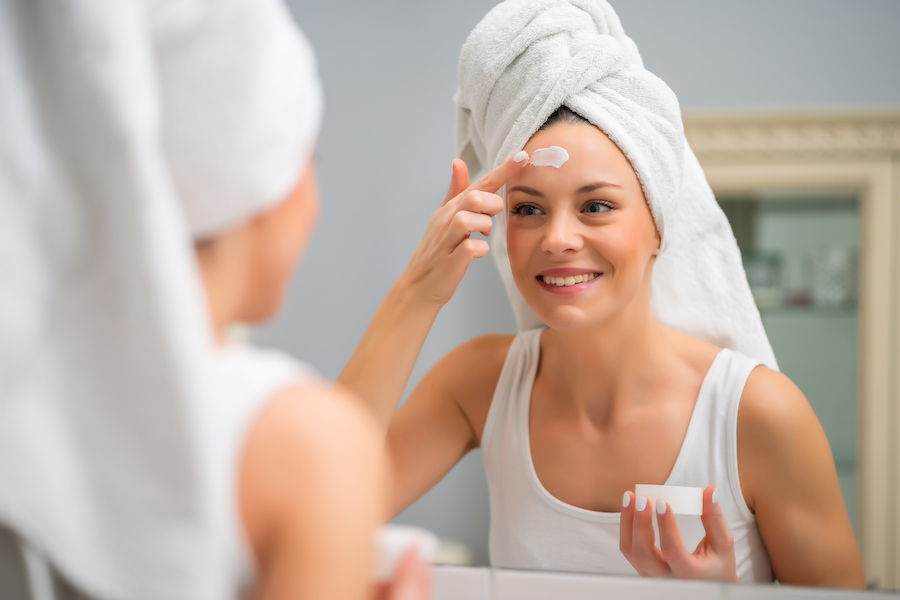
Finally, if you want to remain extra careful to prevent breakouts this season, you may want to try the following products in these steps:
- Cleanser
- Non-comedogenic moisturizer
- Sunscreen
Now, some of these may work better for certain skin types. However, a consistent cleaning and moisturizing routine with acne-specific products is the best way to prevent fall breakouts. These should be used as a morning and nighttime routine daily.
A gentle sunscreen in the morning, after your moisturizer, can certainly help. If you follow the tips mentioned above and use a careful process every day, then you should see a dramatic reduction in seasonal breakouts.
Whatever you do, don't pop or pick at existing acne. This can lead to acne scars or worsening breakouts. There are better ways to treat existing breakouts.
Read More: How To Get Rid Of Acne Scars
Which Skin Treatments Might Help?
If you want to treat an existing breakout, here's some good news: you have options. The tips above are quite effective at preventing breakouts, and we recommend pursuing them either way. However, we don't want our current breakouts to interfere with our lives now.
For that reason, you may want to consider pursuing a professional skin care treatment. This could include chemical peels, facials, masks, and more. There are plenty of skin treatments that can help with acne.
Still, the best treatment you'll find is prevention! If nothing else, stay hydrated throughout the day, follow a reasonable daily skincare routine, and try to watch what you eat. Small changes can make a big difference!
Read More: How Can Laser Genesis Benefit Me?
The Takeaway
Now that you know how to handle some of your fall skin problems put these tips to use today. A little tweaking to your daily routine and the right skincare products can make a world of difference. Feel confident year-round by treating your dry skin in the fall!
Stay up to date with our latest skincare tips, and book a free consultation with us to find the treatment that's right for you!
Five Most Common Skincare Problems
And How To Avoid Them Ruining Your Favorite Season
You know how sometimes you have unexplained breakouts and your skin becomes drier? You're not the only one. Odds are you aren't doing anything wrong and more often than not the culprit is a change in the winds, literally.
Can A Change of Weather Cause Skin Problems?
Put simply, yes, you might notice some changes in your complexion when the seasons start to change. The climate you live in can impact your complexion and changes in it depending on the season.
Let's say you usually have a normal skin type but when it starts to get warmer in the summertime, your skin becomes more oily. That would be because of a rise in temperature and the excess humidity in the air.
In fact, in 2018 a study published by the British Journal of Dermatology revealed the significant links between climate and skin problems. This study looked at the filaggrin levels across 80 people during the winter and into the summer. Filaggrin is an important protein that helps sustain your skin barrier and when processed, it produces key molecules that help with your skin's natural moisturizing process.
The study showed that the rate filaggrin was processed changed significantly from the summer months compared to the winter months. Researchers also noticed changes in the texture and composition of skin cells.
After all, the skin is the body's largest organ, so it's no surprise that environmental factors may stress your skin out. However, depending on your skin type and what season it is, your skin might experience different problems, especially in transitional seasons like fall.
How Does Fall Affect Your Skin
It seems as soon as the first leaf hits the ground, many of us are faced with skincare concerns. After a long, hot summer our skin needs a break from the sun beating down on it causing dehydration and inflammation. Sadly, since fall is a transitional season, we don't get so much of a break as our skin gets a shock. Although you may not have a sensitive skin type, when a change in weather happens, your skin can be vulnerable to environmental changes.
During fall, levels of humidity drop low, which is one of the most important climatic differences to consider since it causes dehydrated skin. The main changes that your skin needs to grapple with during the fall are harsh winds and adjusting to the difference in temperature and humidity.
You might be wondering though, what are the skin problems that most people are affected by? Let us answer.
Dry Skin
This is one of the most common skincare concerns that people experience as the days begin to get shorter and the temperature starts dropping. In the summer, the moisture in the air keeps your skin hydrated but come fall, it gets sucked out of the atmosphere, leaving you with dry skin.
At first, you might not notice your skin drying out, but one of the effects of fall weather taking action is your skin drying out very quickly. One of the culprits causing your dry skin is most definitely harsh winds. The dry, cold wind brushing across your face can be very drying and it strips your skin of its natural moisture.
Another surprising factor that can cause your skin to dry out is stepping into a hot shower after being outside in the cold. Shockingly enough, they are known to be harsh on the skin and can make for dry skin since the hot water strips your skin of many natural oils that help with moisturizing. This can lead to irritated and itchy skin which doesn't make for a fun combo in the colder months.
Eczema
Speaking of itchy, if you struggle with eczema you might have noticed it's starting to flare up once it starts to get colder. This isn't a coincidence either, it's because of the change in seasons. The National Eczema Association defines eczema as an "...inflammatory skin condition that causes itchiness, dry skin, rashes, scaly patches, blisters and skin infections." Doesn't sound fun, does it?
As you might have guessed by now, the reason you might be having a flare-up is because of the drier air and lower level of humidity that comes with fall.
If there's one thing that doesn't help your eczema it would be that since this causes your skin to become dehydrated, leaving you to deal with more irritation and itchiness. Sadly, temperature changes are also not friendly to eczema. That means that, if you want to avoid more irritation, itchiness and redness - hot baths and showers are a big no-no.
Rosacea
Like eczema, rosacea is an inflammatory skin condition. It manifests in redness similar to a sunburn. Flushing on the face is also one of the main characteristics.
Usually, rosacea shows up on the checks and nose but it can also affect the forehead and chin. One trigger for rosacea is heat, so think sun exposure, changes in the weather, and really anything that elevates your body temperature.
In terms of the changing seasons, the cooler temperature and whipping wind might cause you to have some flare-ups. For example, stepping out of the cold and into your warm home might cause your cheeks to flush a bit. In the summer, grabbing an iced coffee was a no-brainer but not that it's cold, switching to hot coffee is the move. However, at the same time, hot beverages can also cause your rosacea to flare up. Annoying, we know.
Read More: How Can Laser Genesis Benefit Me?
Flakiness
If you've been dealing with one of the above skin conditions, dryness or eczema, this term is not unknown to you. Flakiness is caused by itching skin that is already inflamed and irritated. It can also be caused by the abrasiveness of harsh winds and by being outside in cold weather.
Keratosis pilaris
Keratosis pilaris is a skin condition that many people experience. They can look like small bumps on your skin, and in some instances, they have a reddish colouring. The bumps are fairly rough, however, sometimes they are mistaken for pimples or a rash.
In fact, keratosis pilaris is simply dead skin cells that are plugging your skin, which is what forms the bump. In some cases, keratosis pilaris can be itchy and present with redness but they are in fact harmless and can be remedied with treatment.
How Can You Protect Your Skin In The Fall?
Now that you know about these skin conditions and how they can be acerbated by the cold and windy days in fall, you might be wondering how to protect your skin and prevent these skin conditions.
We can't control the weather but we can control how we protect our skin and what steps we can take in doing so. For starters, bundling up with a cozy scarf, some mittens, and a cozy hat will reduce the seasonal impact on your skin. There will be fewer changes of wind whipping across your face and the dry air causing you to lose moisture in your skin.
Another option would be to invest in skin care geared towards helping the skin concern that is flaring up in the colder months. When seasons change, switching out your regular moisturizer for a richer product is a great step to take. What's even better, is combining your skin care products with a bi-weekly or monthly skin treatment.
Read More: The Best Facials For Every Skin Type
What Types Of Products To Use?
There are many products that you can choose from but the key is selecting a product that targets the specific skin concern you are having. Adding in a serum and picking a moisturizer that suits your skin concern is a great first step.
Let's say that this colder weather and dry air have caused dryness and your eczema has flared up.
In this case, your goal is to rehydrate your skin and help your skin retain moisture. You'll want to scout out skincare products with humectant properties. Put simply, it is an ingredient that attracts water molecules from the second layer of skin and brings it to the top layer of your skin, where your moisture barrier is.
A great option to achieve this would be picking a moisturizing complex that contains a humectant or moisturizing vitamins such as Vitamin E. Another great skin care product that would enrich this process would be a hydrating serum, containing a cooling component. A serum of this kind is a great selection for people who experience rosacea or inflamed skin conditions.
A broad-spectrum sunscreen is essential for those experiencing rosacea flare-ups, especially since prevention is the best remedy. Even if you don't suffer from rosacea, adding good sunscreen to your skincare is a must. Everyone needs protection from harmful UVA/UVB rays that can penetrate your skin, rain or shine. Speaking of something for everyone, you can't go wrong with scheduling a bi-weekly or monthly facial with a focus on hydration.
The Takeaway
Now that you know what skin concerns you might encounter this fall, you have some ideas on how you can prevent, protect, and remedy anything that comes your way!
How To Get Rid Of Wrinkles?
What You Should Know About Wrinkle Fillers
It's happened. The day you knew would come, but never so quickly.
You've got wrinkles.
Whether they're crow feet, smile lines, or fine lines, no one really wants to show their age. Wrinkles may seem like an inevitable part of aging. But luckily, there may be a way to get rid of them.
In this guide, we'll discuss how your wrinkles form in the first place. Then we'll talk about how you can get rid of them. That youthful skin you've always wanted is right there for the taking.
From Fine Lines to Crow Feet: How Do Wrinkles Form?
As the body's ability to heal and repair declines, so does its ability to maintain youthful skin. This process is different for everyone, and genetics play a huge role.
Your skin begins to lose its elasticity, which in turn makes it more fragile. Fat deep in the skin layers diminishes, and so does oil production. The result is skin that creases and folds rather than returning to its original form.
Other lifestyle factors contribute to skin wrinkling. If you get lots of sun exposure, smoke, or don't care for your skin, it will wrinkle faster.
How Do You Prevent Wrinkles From Forming?
The first answer is to make lifestyle changes. Wear sunscreen when you go out, quit smoking, and use moisturizer. However, these are preventative measures that won't have a drastic effect after you have wrinkles.
Regular skin care will make a huge difference. Masks and facials are a great way to go. However, you may want more extreme results.
There are several options:
- Topical serums and creams
- Laser resurfacing
- Peels
- Microneedling
- Dermal fillers
Topical Solutions
If you want a less invasive solution, you can try topical creams and serums.
Topical retinoids are prescription drugs that work great for fine lines and other skin marks. Using them for a few months should get you noticeable results. However, they will make your skin sensitive, necessitating sunscreen.
If you want to go the non-prescription route, you can try anti-wrinkle creams. Keep in mind, these creams will have fewer active agents than those found in prescription creams. That means results may take longer and be less noticeable.
Laser Resurfacing
A common treatment is laser resurfacing. The laser destroys your outermost layer of skin (the epidermis), which heats up the layer beneath (the dermis). This process provides stimulation for collagen fibre growth. The result is tight, smooth skin during the healing process.
However, laser treatments work best for skin that isn't already sagging. This procedure requires a local anesthetic, may require sedation, and can take several treatment sessions. There are other laser procedures that are less intense for those with moderate wrinkling or sensitive skin.
Peels
A doctor applies a chemical peel to your skin. This removes upper layers, which when healed, look more youthful. This procedure will lead to sensitive, reddened skin for a time.
Peels are a great, non-invasive way to get youthful skin. They use your body's natural healing to get the intended result.
Microneedling
Microneedling is a new, non-invasive procedure that involves injecting the skin with tiny needles. These needles cause micro-injuries, which prompt your body to begin healing itself. This is great for evening out skin tone and reducing fine lines or surgery scars.
Wrinkle Fillers
Dermal fillers are a temporary way to make your skin look new. The doctor injects your skin with a solution. It smoothes wrinkles and other problem areas but is usually not a permanent answer to skin wrinkles.
Find a reputable doctor who can administer dermal fillers in Ottowa.
Types of Wrinkle Fillers
The type of solution the doctor injects depends. The most common is hyaluronic acid, which is already a natural component of the skin and promotes the connection of tissues. The result may last up to a year.
Calcium hydroxylapatite helps to restore the jawline, as well as the cheeks. It also lasts about a year before you need to reapply.
A soft tissue filler such as Bellafil may allow you to permanently reduce deep wrinkles. Since your body cannot break it down or absorb it, this procedure should give long-term results.
Fat grafting involves removing fat from your own body and then transplanting it to your face. This can provide a long-term solution to hard-to-remove wrinkles.
Wrinkle Fillers Vs. Botox
As the name implies, wrinkle fillers work by filling the site to smooth wrinkles. On the other hand, Botox works by relaxing the muscles that cause wrinkles. Smile lines and crow feet often occur due to the movement of your face muscles.
It's important to find a qualified professional who can administer Botox in Canada. Too much Botox can give undesirable results and limited feeling in the face. Done properly, it works great for removing crow feet, mouth wrinkles, frown lines, forehead lines, and a gummy smile.
You will need small doses of Botox, and the effect will last several months. You will need to return for repeat injections in order to keep the results. Make sure to get a trustworthy doctor who can inject Botox in Ontario.
Remove Your Wrinkles Today
It may seem inevitable that your skin will wrinkle as you age. However, there are a wide variety of procedures can that help to remove everything from fine lines to smile lines. These procedures are often non-invasive and allow you to return to work the same or the next day.
There's a skin rejuvenation clinic in your area. Book an appointment today and see the difference that skin rejuvenation can make.
Common Questions About Lip Fillers
Things You Should Know Before Booking An Appointment
Not as much stuff has taken the world by storm as lip fillers have. Their rise in popularity started a few years ago and it seems as if they're here to stay.
In a world of social media and the overall increase in self-consciousness has led people to think more about their appearance, finding more and more 'mistakes' on their bodies and faces.
We'd like to start this article by saying: there is no such thing as a mistake on your body.
Yes, lip fillers are a fast and relatively harmless way to add touch-ups and maybe help you feel more comfortable in your skin. But cosmetic procedures should never be your go-to solution for feeling empowered or more beautiful. Remember, as much as it sounds like a cliche, beauty really does come from within. Lip fillers, lasers, hair colours, cosmetic surgery, etc. - should just be that extra oomph you're looking for, not the main thing. You're awesome as you are! The world is much more interesting when we're all different and proud of our own features!
On the other hand, it's understandable that you might be thinking about getting lip fillers. All of us have that one thing we would like to change about ourselves, and for some - it's the desire for more plump lips - and you have every right to do so! But, you should always remember lip injections are a real procedure that does come with possible risks.
That being said, let's talk about all of that, shall we?
What Are Lip Fillers Made Of?
Lip fillers usually consist of hyaluronic acid, which is a substance your body already has. They're a type of dermal fillers and are used to achieve various results. Hyaluronic acid lip fillers are the most used type of lip filler. Their effect usually lasts between six months to a year. Other types of lip fillers are collagen and fat injections or implants. These are not that much used today, since hyaluronic ones gave fewer risks and side effects associated with them.
Read More: What You Should Know About Dermal Fillers
What Can Lip Fillers Do?
There are many reasons a person might choose to get lip fillers. For some, it's because they're not a fan of their thin lips and would want to add some volume. Others might want to correct the shape of their lips and make them more symmetric. Then, some people just want to restore the size of their lips and make applying lipstick more enjoyable.
What To Expect From The Procedure?
If this is your first time, your lip filler journey will most likely start with a consultation appointment. There, a professional will talk you through the whole process, explain the possible risks and let you know the amount of fillers needed and the cost. After a while and you thinking things over, you will book an appointment. Here's where you'll start to get excited!
When you finally get to the appointment, a numbing creme will be applied to your lips. After a few minutes, a certified injector will mark the areas where they'll need to inject and use fine needles to put the filler in your lips.
You'll notice the result right away. However, only after around two weeks will you be able to see the real change, after the initial swelling goes away completely. The biggest swelling occurs in the first 48 hours.
The Aftercare
After getting the injections, your lips will be swollen and might even be bleeding a bit on the injection spots. This is not something you should worry about and is completely normal. The redness and swelling should go away after a few days - if it doesn't and you notice pain and swelling only getting worse, call your provider and/or physician immediately.
You should stay hydrated and avoid alcohol for at least a day. Avoid heavy lifting and exposure to heat. Also, don't touch your lips a lot or massage them right away.
Your provider will for sure give you some extra after-care tips and schedule a follow-up appointment or phone call.
Advantages Of Getting Lip Fillers
The biggest advantage is - if you don't like what they look like on you, you can take them out. The process is fully reversible. Also:
- Low risk of complications
- Safe procedure
- Can help you boost your self-esteem
- Relatively painless
- No actual downtime
Possible Risks
As with any other procedure, getting lip fillers comes with possible risks, especially if you're someone that has cold sores often. The most common risks are:
- Migration of the filler
- Infection
- Tissue death
- Cold sore reactivation
- Bleeding and pain in the injection area
- Tenderness
Read More: 7 Things You Should Know Before Getting Injectables
However, a lot of that depends on the product used, the experience of the person injecting the fillers, and your behaviour after the treatment.
How Long Do Lip Fillers Last?
Depending on your age and frequency of getting lip fillers, their lasting varies. For example - if this is your first time getting lip fillers, they might last around 4-6 months, for some even more. If you already had fillers before - they might last up to 18 months. Also, age plays a role in the life expectancy of a filler. Younger people break down calories faster, so lip fillers don't last as long.
Can You Get Lip FIllers While Pregnant?
That wouldn't be very wise, according to some.
Pregnancy is a time when many expectant people become more cautious about what they put into their bodies, simply because they're afraid that something might hurt the baby.
Even though there isn't any definitive risk that doing fillers will harm your baby, many providers still advise waiting until you've given birth. That's because, during pregnancy, your hormones are off the charts and have the power to do a lot. The hormones in this situation can cause issues with blood flow and swelling and might cause more problems during recovery. So, it's best for you to avoid them.
The same goes for breastfeeding.
How Much Do Lip Injections Cost
The price of lip filler varies among clinics but it's usually in the $500 to $1000 bracket. At MC Laser Clinic & Hair Salon, a mini lip plump with a 0.5 ml injection of hyaluronic acid filler will cost you $300. This one is ideal for first-timers, those who already have fuller lips or want hydration only. Check out the prices here.
The Takeaway
Yes, lip fillers are a nice and safe way to get that extra plump in your lips. But, as we said in the beginning - don't let today's world make you feel less beautiful whatsoever. Lip fillers are not everyone's cup of tea - and that's okay! At MC Laser Clinic & Hair Salon, not only do we have expert injectors that will make you feel safe and pampered, but we also have other treatments that can help you feel relaxed and taken care of. Whatever you decide to treat yourself with, we're here for you and can't wait to meet you! Get in touch today!
What You Should Know About Dermal Fillers
Common Questions About Injectable Treatments
Around 80% of young women in Canada use editing features on their phones before posting selfies or other pictures on social media. This new technological era has ushered in a realm of self-confidence issues regarding looks. Whether you notice the tell-tale signs of ageing or have sunken cheekbones, you may wonder if there are other options outside of invasive plastic surgery measures.
For starters, cosmetic procedures should never be used solely to improve confidence or self-esteem. Yet, minimally invasive or non-invasive options like dermal fillers provide you with an easy, affordable, and safe method to enhance your natural beauty. In our complete guide, we have broken down all your questions regarding dermal fillers and how you can get started with treatment today.
Keep reading on for more information!
What Are Dermal Fillers?
In general, there are four primary types of dermal fillers and what is included in each injection. The different dermal filler substances include:
- Autologous fat
- Collagen
- Hyaluronic acid
- Other biocompatible materials
While dermal fillers and Botox fall under the same category as "injectables," they are not the same. As we mentioned in out previous post, Botox is a neurotoxin that essentially paralyzes muscles (safely, of course). It is widely used as a means to temporarily eliminate or reduce facial wrinkles.
Botox is also used to treat several medication conditions, like TMJ syndrome, excessive sweating, or migraines. Contrarily, dermal fillers add volume to facial features. It is solely a cosmetic treatment that also shares some of the same benefits as Botox, such as reducing the appearance of wrinkles.
What Are Dermal Fillers Used For?
Dermal filler injections are used for static wrinkles or to improve volume. Other uses of dermal fillers are:
- Reducing scar appearance
- Reducing fine lines
They are often used on the cheeks, lips, or other facial areas. In some cases, a qualified nurse injector may use it on your hands. Some of the dermal filler benefits are its long-lasting results, minimal side effects, and enhanced facial features.
How Do Dermal Fillers Work?
Have you wondered how dermal fillers work? Now that you know some of the ingredients in them, dermal fillers are injected into specific facial areas like your lips, cheeks, or jawline.
It uses a gel-like substance that helps plump the area where natural ageing has worn away collagen and proteins. Hyaluronic acid injectables are one of the most popular options since it naturally occurs in the body and helps moisturize and plump your skin.
Read More: Seven Things You Should Know Before Getting Injectables
How Long Do Dermal Fillers Last?
Dermal fillers' longevity depends on a few factors. First, the type of dermal filler used and how it was administered play an essential role. This is why you should only use a reputable and qualified clinic for dermal filler injections.
Next, your skin type can also affect how long dermal fillers last. On average, dermal fillers last longer than Botox. You can usually continue seeing positive results between six months and two years.
How Long Does It Take for Dermal Fillers To Settle?
Everyone will respond differently to noticeable results from dermal fillers. In some cases, it may take a few days. Others might not see the full results for a couple of weeks.
Can You Go in the Sun After Dermal Fillers?
You should avoid excessive exposure to UV rays as a general rule of precaution. However, exposure immediately after dermal filler injections can weaken or degrade the product. Ask your nurse about a more specific timeline, but it is essential you avoid the sun until your fillers have fully set.
Are Dermal Fillers Permanent?
Most used dermal filler placement injections are semi-permanent or dissolvable. These characteristics can make them safer for a wider range of individuals.
For example, autologous fat, collagen, and hyaluronic acid are naturally produced in the body. Over time, your body reabsorbs these products and doesn't view them as foreign objects. While you may have to make more appointments long-term, they can reduce the risk of serious side effects.
Are Dermal Fillers Safe?
Most risks are mitigated by choosing a reputable cosmetic clinic. With injectables, there are some risks to be aware of, such as:
- Blocked blood vessels
- Vision loss
These are extremely rare and usually due to inexperience from the person delivering injectables. However, there are also some side effects you may experience after dermal fillers that are not a cause for concern, like pain, bruising, and swelling. These should dissipate shortly after.
After Care for Dermal Fillers
Like Botox, you should avoid massaging or touching the area that was injected. Do not visit a tanning bed or expose your face to direct sunlight. Talk to your nurse injector about when you can start lightly applying makeup or other products.
How Much Do Dermal Fillers Cost?
While Botox usually costs around $10 per unit, the cost of dermal fillers varies on the quantity and type of filler used. For lip fillers, you can expect products such as hyaluronic acid. If you had a filler administered elsewhere but don't like the results, MC Laser Clinic and Hair Salon can remove it for $100.
Should I Get Fillers?
If you start noticing deepening lines around your nasolabial folds, it might be time for dermal fillers. Unlike wrinkles that arise with facial movements, ones engrained at rest (such as lines around your mouth) are more ideal for fillers.
Additionally, if you want improved bone structure from sunken cheekbones or more plump lips, fillers can restore or enhance features and shape. This benefit makes it ideal for younger and older adults who want a minimally-invasive approach to voluminous features.
The Takeaway
Dermal fillers are an excellent way to manage wrinkles and start reversing the ageing clock. Even younger adults can benefit from injectables to improve the appearance of their cheekbones, chin, or jawline. While not a permanent solution, it is longer-lasting than Botox and has few risks associated.
If you're looking to get dermal fillers in Ottawa and are not sure where to start - how about our place? MC Laser Clinic and Hair Salon offer several cosmetic services we know you'll be happy with! Contact us today and get started with your dermal filler appointment!
Read More How To Look Younger Without Surgery Oo Injectables
7 Things You Should Know Before Getting Injectables
Cost & What to Expect for Lip Injections, Face Fillers and Botox®
Are you thinking about getting some fillers and chasing that younger look? Exciting! Welcome to the feel-good club! We're all about doing what we love, not judging and feeling pretty! And smart, too.
But, before you go ahead and book an appointment, it would be wise to get some pointers first. Just so you know what to expect, what injectables and fillers actually are, and how to prepare for everything. The more informed you are, the better!
So, to help you get all the crucial information you need, we compiled the most asked fillers questions on Google and are here to answer them for you. Let's dive right in, shall we?
1. What Kind Of Injectables Are There?
First, let's cover the basics - what's out there?
Well, the most popular solutions when it comes to injectables are neuromodulators (Botox®) and dermal fillers (like hyaluronic acid lip fillers, for example). Sure, there are more options out there and a lot of science behind them, but we will focus on the most popular and most used options.
When it comes to dermal fillers, there are four basic materials used in them: autologous fat injections, collagen products, hyaluronic acid products and injections of a carrier material containing microspheres of another biocompatible material (PMMA).
Contrary to the popular belief, Botox® is not the only solution for wrinkles - dermal fillers can do the same. They help reduce the appearance of wrinkles, create structure (jawline, for example), add volume to the lips, etc.
Botox® on the other hand is a neuromodulator, so it can be used for the treatment of some neurological disorders. But, as mentioned above, it can also be used as a "wrinkle remover". Yes - we know what you're thinking and you're right - it being a neuromodulator is the reason behind the "frozen face" when overdoing it.
To simplify - dermal fillers are mostly used to add volume and shape specific areas of your face, while Botox® will relax your muscles and smooth (or lift) everything out.
2. How Long Do They Last?
Results can vary among people because it all depends on your skin, the quality of the products, the way it was administered, etc.
In general, Botox® results last around three to four months, while dermal fillers last anywhere between six months and two years. It depends on the product used and the area treated.
3. Who Can Inject Fillers In Ontario?
To be allowed to inject fillers in Ontario, you have to be a Medical staff - such as a licensed physician, dentist, registered nurse, or a certified nurse injector for those treatments. Proper training and experience are absolutely crucial. At MC Laser, it's our Ana that has all it takes to take care of your needle needs! Our Ana has it all!
4. What Are the Downsides of Using Injectables?
As we age, our appearance changes - shocking, right? We know. What we mean by that is that over time, natural HA decreases giving us thin and sagging skin. The more we age, the more it happens and the more treatments are needed.
It's also important to know that neurotoxins like Botox® are used for wrinkles that are "active" - wrinkles that only appear with a specific movement - think forehead wrinkles when you play with your eyebrows. Dermal fillers on the other hand are used for wrinkles that are always there, such as crowfeet.
Why did you have to know that? Because it will make it easier for you to understand the possible side effects - like with Botox®, it can sometimes happen that your muscle gets too relaxed and your eye drops for example. It usually happens when not done properly and the consequence can last for about 3 months!
For both injectable options, it can take more appointments to achieve the results you want - that again depends on your age, your skin, etc.
Here are some reactions Health Canada reported on:
Typical Downsides of Dermal Fillers
- pain
- bruising
- redness
- swelling
- raised bumps
- sores
- infections
- skin discoloration or hyper-pigmentation
- allergic reaction
- improper placement of the material
Typical Downsides of Botox®
- pain/bruising at the injection site
- headache, face pain, eye swelling
skin rash - local muscle weakness/paralysis of the face
- irregular heartbeat/chest pain
- feeling generally unwell
5. What To Expect From A Treatment?
If it's your first time getting fillers or any work done, your treatment will most likely start with a consultation appointment. At the appointment, your professional will let you know all about the possible side effects you might experience, how everything works, what you can expect, etc. Ask your provider if they think you're a good candidate for this and how many treatments will you need to get the results you want.
Take some time after the consultation and think about if this is what you really want.
After you decide that it is - you will book your appointment and go to your treatment. Your provider will take some "before" photos and prepare you for the needle. They will clean the area first, put some numbing cream and inject a specific, pre-determined amount of product. The procedure can last around 15 to 30 minutes. With fillers, the results will be there instantly however you should wait for the swelling to pass fully - around two weeks. But, the initial swelling is usually gone in the first two to three days.
With Botox®, you might wait up to two weeks to see some results.
After the treatment, you can expect some swelling and pain - but shouldn't be severe and distract you from going on with your life. If it does, contact your doctor immediately.
You shouldn't need any medication to manage the pain.
You should not get any of this done if you're pregnant or breastfeeding.
6. How To Prepare For An Injectables Treatment?
There isn't a specific way to prepare for your treatment other than going through consultation and doing your research.
However, if you are on blood thinning medications or take Aspirin, Tylenol, Ibuprofen, ginseng, etc - you should avoid it for the day. Inform your aesthetician about it during consultation. Also, it might be a good idea to avoid caffeine or any dehydrating food/drinks for at least a day before your appointment.
7. How Much Do Injectables Cost?
The price varies, depending on the brand and the amount you need.
On average, a Botox® treatment costs about $400, depending on the number of units. The average price is 10-15 dollars per unit.
A filler treatment on the other hand ranges between $500 to $1000.
The Takeaway
Did you know that the average person thinks about getting filler for around two years? Yeah - and with good reason. As much as we know these procedures are safe and can't hurt you if the work's done properly and by a professional, needles and injecting something into your body does sound scary. This is why a lot of research and consideration is needed. We hope we helped a bit!
How To Keep Your Hair Healthy In Summer
Fighting The Sun At Its Best!
After the long winter months, summer is finally upon us. As much as we look forward to the balmy, long days, the warmer weather can play havoc with your hair.
Natural hair and beach waves are on the cards, as it’s the season to embrace a loose and natural look. However, as nice as the heat and rays feel, they can leave your tresses looking lifeless and lacklustre.
Your summer hair care routine doesn't have to be complicated and there are several easy things you can start doing today to keep your hair healthy all summer long. In this article, we delve into how to protect your hair from the heat, humidity and sun with minimal effort.
What Damage Can the Sun Do to Your Hair?
If your hair is exposed to the harmful rays of the sun for long periods of time, it can cause substantial damage.
The UVA and UVB can damage the hair cuticle, which is the protective outside layer of hair. When this is damaged the result can be brittle and dry hair which leads to split ends and frizziness. It can also cause discolouration and in worst cases, thinning of the hair.
Swimming Damage
Imagine, sitting by the pool, sipping on a cocktail. Naturally, you’re going to want to take a dip to cool off. However, the chlorine in the water is detrimental to the condition of your hair. Chlorinated water makes your hair weak and dry. In turn, this causes breakage. If you have dyed or bleached hair, the chlorine can also taint it.
The best way to avoid getting chlorine in your hair is to tie it up so it doesn't get wet. If you really can’t resist going underwater, then rinse your hair as soon as you get out of the pool to minimize damage.
Summer Hair Care Tips
Whether you’re off on a summer vacation soon or relaxing in your backyard, follow our easy summer hair care tips to keep your locks looking in great condition. These six ideas will help make sure you have glossy locks all summer long.
Get a Haircut
By far the easiest solution to getting rid of damaged hair strands is to get a haircut. Summer is a great time for a new hairstyle. Not only is it a great time of year for a new look, it taking some of the lengths of your tresses is a quick way to cool down.
Once your hair had been damaged, and the split ends have set in, it’s impossible to repair the damage. If your hair is tangly and knots easily, split ends could be the reason. You can use various serums and hair masks to give the appearance of non-damaged hair, but unfortunately, the only way to truly get rid of them is by cutting them off.
Use a Hydrating Shampoo & Conditioner
Frizzy hair is caused by a mix of environmental factors, your natural hair type, and hair damage. If you have frizzy hair, you can do several things to combat it.
Hydrating shampoos and conditioners contain ingredients to replenish the moisture in your hair. They help to keep your hair supple and seal the cuticle.
When you’re choosing a hydrating hair product, look for ones that contain ingredients like argan oil, coconut oil and butter, shea oil and avocado oil. These all contain properties that trap moisture.
Apply a Hair Mask
If you have sun-damaged hair it’s a good idea to use a hair mask to help repair any damage done. A hair mask is a little bit like a thick conditioner or oil. However, you soak your hair with it for a prolonged time.
For best results, use a hair mask after shampooing. Apply the mask, and then wrap your hair in a towel. Leave it on for as long as possible to let it soak in properly before rinsing out. For a more intense remedy, you might want a keratin smoothing treatment.
Use Products With a UV Filter
So we know about the importance of protecting our skin from the harmful rays of the sun by applying an SPF lotion, but we often overlook our hair.
When skin is exposed to the sun without protection, the tell-tale warning is sunburn that we can see and feel. However, it’s more difficult to see the damage from the and you can’t feel it at all. If your skin can be damaged, then so can your hair.
There are several UV-containing hair lotions that you can apply to your locks before going out in the sun to protect them. Another way to stop hair damage is by keeping your hair under a hat.
Use Leave-In Conditioner Before Swimming
We mentioned earlier in this article the negative effects of chlorine on hair. If you’re planning on going swimming in chlorinated water, then a great way to protect your hair is by using a leave-in conditioner.
This works by adding an extra barrier to your hair and protecting your hair's cuticle. Before going into the pool, dampen your hair in the shower, then apply a liberal amount of leave-in conditioner. Rub this in so that all of your hair has a generous coating on it. Your hair will be protected from the pool water, the chlorine will not touch your hair. When you get out, have a shower to rinse your hair and body of chlorine.
Skip Blow Dryers, Flat or Curling Irons
Exposing your hair to excessive heat changes the shape of your hair's keratin strands. Over time, this leads to weaker hair that’s more prone to damage. Give your hair a break from the damaging heat tools in the summer months.
Summer is a great time to let your hair dry naturally, and embrace the natural waves or curls in your hair. If you do find your hair is uncontrollable, then use a light serum, oil or wax to help tame it.
Keeping Your Hair Healthy in Summer: The Takeaway
This guide has given you great tips on keeping your hair healthy this summer. They are simple to e easy to incorporate into your current routine.
The key takeaways from this are to prevent the sun and pool from damaging your hair by using a mix of UV-protecting sprays and conditioners. Give your hair a hydrating treatment to reduce any damage done, and treat yourself to a fresh new haircut to get rid of split ends.
For the more great hair care tips for keeping your tresses in tip-top condition contact our knowledgeable team to find out more about our hair salon services.
Summer Body-Care Tips
How To Take Care Of Your Body In Summer
With the summer holiday season upon us and after the dynamics of the past two years, we can finally look forward to a well-deserved summer vacation. As we all flock to the beach to enjoy the glorious sunshine, it can be too easy to forget about the importance of body-care, and how to keep ourselves looking great.
But what are the easiest ways to do this? You don’t want to spend your precious holiday following a strict beauty regime. I get it. You want to be out and enjoying yourself.
This article covers all the essentials you need to know about keeping your body in tip-top condition during summer. No one wants to spend hours in the bathroom every morning and night. These simple ideas can easily be incorporated into your daily route, leaving you more time to look great and enjoy the summer.
Does Your Body Need More Care During the Summer?
Our bodies can take quite a bashing during the summer months. Long beach days, drink-infused pool parties, and the scorching sun are a few things our bodies have to contend with.
It’s no wonder that our skin health in the summer starts to suffer. Yet, there are some simple things you can put in place to help ensure your body stays fit and healthy.
You should be caring for your body all year round; what changes is the way you care for it. It doesn't necessarily need more care, you just have to switch your daily routine up to suit the season.
The first main difference is that with the warmer weather, we sweat more. Our bodies will naturally lose a lot more water and with it essential electrolytes.
We all know how important water is for keeping healthy both inside and out. Not getting enough can cause our skin to look dull and flaky.
Which Body Products to Use in the Summer?
Walk into any store, and no doubt you’re bombarded with a mountain of products that promise to work wonders on your body. However, there are only three that we swear by. A body scrub, a good quality lotion, and sunscreen.
Body Scrub
Exfoliation definitely needs to form part of your summer skincare routine. Exfoliating your skin helps to remove the layer of dead skin cells that sit on the skin surface. These dead cells can clog up the skin, and give it a dull or flaky look.
By gently removing the dead cells, you leave your skin looking fresh and healthy.
You can exfoliate by using a loofah, or choose a body scrub. If you choose a body scrub, go for one with a natural base, such as ground-up pieces of nut, salts, or pumice.
Lotion
Wow, where do we start with body lotions? This can be a bit of a minefield. invest in a couple of different ones here: one for day and one for night wear.
One thing to look for in day lotions is that they aren’t greasy. There’s nothing worse than having sweaty skin, and then a layer of oily cream floating on top of it. Our Youth Body Serum solves that problem.If you're looking for something above and beyond any other body products you tried before, this is it.
You want to find a lotion that’s quickly absorbed into the skin and provides all-day hydration. Try to choose one that has an SPF factor.
For the nighttime, choose a thicker lotion, like rich body butter or hydrating oil which will replenish your skin overnight.
Sunscreen
Even in the winter months, we should be wearing sunscreen to protect us from damaging UV rays. In the summer, it’s even more important, not only to prevent our skin from prematurely ageing but to protect us from skin cancer.
Ideally, your sunscreen should be UVA and UVB certified. When you’re choosing sunscreen, we also recommend wearing at least an SPF of 30. Apply sunscreen regularly throughout the day, especially if you’ve played a sport or been in the water.
Hair Removal During Summer - What You Need to Know
With our legs and bodies on show throughout the summer, there’s no hiding behind layers of clothing from the winter months. We know there are various methods of hair removal, but which one is best, how often do we have to do it, and what aftercare is there? This section looks at three of the most popular hair removal options.
Waxing
Waxing can last up to anywhere between 3 - 6 weeks, especially if you have it done regularly. You can buy home kits, although I’ve had the best results from waxing by going to a salon. It can be painful, especially in the bikini line.
One of the downsides of waxing is that you have to let your hair grow a little bit to ensure the whole hair is pulled out. This can mean up to two weeks of stubble while you wait. But then the payoff is around a month of no hair.
Shaving
This is one of the most convenient methods of hair removal and is easiest done in the shower. However, the downside is that it needs doing daily, especially if you’re after silky smooth legs.
One of the downsides is shaving rash, especially around clammy areas like the armpits and bikini line. Also, ingrown hairs are a very real thing (remember our point on exfoliation earlier, which can help reduce ingrown hairs).
Laser Hair Removal In Summer
This is the most expensive option, however, it’s also the most effective. Laser hair removal works by using a powerful light to heat and destroy the hair follicles. Most people will have a session every 4 to 6 weeks. The regrowth lessens each time.
Laser hair removal is definitely one of the more convenient hair removal methods. But, when it comes to getting rid of your hair using this method, you have to be careful: don't undergo a treatment if you plan on exposing your skin to the sun. Your skin should be avoiding direct exposure to sunlight after the treatment so it's wise to this in the evening!
How to Keep Your Body Hydrated in Summer
To maintain a healthy body during summer it’s important to stay hydrated. Your body will get water through food, so consume foods that have a high naturally high water content, like melon, grapes, pineapple, and celery.
You can also help your body stay hydrated by avoiding diuretics, such as caffeine. As ideal as sipping cocktails next to the pool sounds, it’s also worth cutting back on alcohol. If you are drinking alcohol, have a glass of water between each alcoholic drink to help balance it out.
Summer Body-Care Tips: The Takeaway
This guide has given you some great summer body-care tips that are easy to incorporate into your current routine.
Remember to stay hydrated inside and out, buy using a good quality lotion, drink lots of water, and always protect yourself with an SPF 30 sunscreen.
For the smoothest legs this summer, laser hair removal is the fuss-free option to go for. It’s not painful and lasts for weeks. Contact our knowledgeable team at the clinic today to find out more.
How To Keep Your Skin Clear In Summer?
Tips & Tricks For Glowy Skin
Did you know that more than 20% of Canadians suffer from acne? Acne is one of many skin conditions that affect people all over the world.
Fortunately, with the help of summer skincare essentials, you can learn how to keep your skin clear in summer in no time. Keep reading to learn more about how to get glowy skin and how to take care of your skin in summer.
How Can Summer Affect Your Skin?
During the summer, the sun's UV rays will be stronger than ever. More than that, the temperatures will rise and you will be more likely to lose water through sweat. While this might not seem like a big deal, losing moisture and getting dehydrated is not great for your skin.
Being out in the sun for too long isn't ideal either. While it might be tempting to get a nice tan during the summer, that tan is going to do much more harm than good, especially in the long run. Of course, this doesn't mean that you have to avoid the sun altogether.
Fortunately, learning how to supplement and protect your skin during the summer isn't hard at all.
Why Is Having A Skincare Routine Important?
Having a good skincare routine is important for protecting your skin. This is especially important if you're concerned about how your skin will age. If you don't take good care of your skin while you're young, you may develop wrinkles prematurely.
You may also develop other skin problems such as saggy skin and liver spots. Of course, no one wants to have these skin problems at all, let alone prematurely. Fortunately, there are several ways to keep them at bay for as long as possible.
Tips For Summer Skincare
When it comes to summer skincare, the main thing you will want to do is protect your skin from the sun. Besides that, you will also want to keep your skin clean. When it's hot and you start to sweat, the bacteria in your sweat can irritate your skin and cause all sorts of skin problems, especially acne.
Also, the loss of moisture through sweating can make your skin look dull and sad. This, of course, is not ideal, no matter what kind of skin type or skin care routine you have.
Use A Gentle Foaming Cleanser
There are many types of skin care available, but a foaming cleanser is the foundation of most routines. That's because foaming cleansers are gentle while still being able to penetrate your pores and remove dirt and bacteria.
After using a foaming cleanser, you will immediately be able to see how your pores look cleaner and how your skin looks smoother.
Close The Pores With A Toner
It is important to keep your pores closed, otherwise, they will pick up more dirt. To keep your pores tight and closed, use a toner. You will want to avoid alcohol toners since they can irritate and strip your skin.
Instead, use a natural toner such as witch hazel. This will protect your skin while still cleaning and tightening your pores.
Use Serums
To truly give your skin a boost, you won't want to skip on serums. Vitamin C serums are especially helpful. That's because they are full of antioxidants.
Antioxidants can keep inflammation at bay. This is not to mention that vitamin C can fade dark spots.
Keep Skin Hydrated
As mentioned before, keeping your skin hydrated is important during the summer. Hydrating masks can help with this.
By trapping moisture against your skin, masks can provide your skin with an extra boost in hydration. As a result, your skin will look plumper and smoother.
Exfoliate Regularly
Exfoliating regularly is important because it will keep your skin fresh while doing away with old skin cells. Microneedling is a particularly great way to keep your skin fresh during the summer.
By puncturing your skin with tiny needles, you can stimulate your skin to produce collagen. This will make your skin look much more youthful and smoother than before.
Lightweight Moisturizers Take The Stage
After exfoliating, you need to moisturize. Otherwise, your skin will be dry and susceptible to damage.
Lightweight moisturizers are great for most skin types. They also won't clog pores.
Watch The Eye Region!
The eye region is perhaps the most delicate part of your face. For that reason, you will want to keep it healthy with moisturizers and other creams.
When applying creams to this region, always dab them on. That way, you won't pull the skin and cause wrinkles.
Sunscreen Is A MUST
If you don't use sunscreen, the sun's UV rays will damage your skin. This will result in wrinkles, sun spots, and other problems.
Using sunscreen that is at least SPF 30 can prevent these problems. It can also prevent skin cancer.
Avoid Heavy Makeup
Summer is not the time for heavy makeup. The heat tends to make makeup melt.
This is not to mention that heavy makeup can cause pores. This can make acne worse if you already have it.
How Can Your Diet Help Your Skin
What you put into your body is just as important for your skin as what you use topically. By drinking more water, you can flush toxins out of your system and keep your skin healthy. By avoiding sugary foods, you can reduce any inflammation your skin might be experiencing.
Finally, eating more fruits and vegetables can provide your body with antioxidants, vitamins, and minerals, all of which are perfect for healthy skin.
The Takeaway of Your Summer Skincare Essentials
When it comes to summer skincare essentials, you'll have a lot to consider. By using serums, moisturizers, exfoliating treatments, and more, you can keep your skin healthy throughout the summer and throughout the rest of the year as well.
To learn more, contact us here.
Facial Hair Removal In Summer
Waxing vs. Threading - Which Option Is Better?
Women who suffer from facial hair are often embarrassed and go to any lengths to have it removed.
But did you know that one in fourteen women struggle with excessive facial hair? And getting rid of that hair can be detrimental to your skin in the summer if you don't take precautions.
Waxing and threading are the two of the most popular facial hair removal methods used in salons right now. Yet, they both have advantages and disadvantages.
If you want to learn more about which method is more efficient and beneficial to your skin, continue reading.
What's Waxing and How Does It Work?
Waxing is a painful procedure where hot wax is applied to the skin in the direction of the hair growth. A cotton strip is placed over the wax, and pressure is applied.
Finally, the strip is pulled in the opposite direction of the hair growth in one swift motion, ripping the hairs from their roots.
Each time you wax, you damage the hair follicles, causing them to weaken. That's why waxing over a long period of time causes a reduction in hair growth.
While there are many advantages to waxing, it's not for everyone, and you should know all the facts before taking the plunge.
Pros
- Hair takes 2-6 weeks to grow back
- Reduces thick hair growth
- Exfoliates the skin
- No itching
- Fewer ingrown hairs
- No more shaving rashes
Cons
- It is not pain-free
- Hair needs to be a certain length
- Causes irritation and temporary redness
- Pores can get clogged
What Is Threading and How Does It Work?
Facial hair threading is an ancient form of hair removal that originated in Iran. It involves taking two threads of cotton/polyester and trapping the hair between them before pulling it from the follicle.
It differs from tweezing because you can remove an entire row of hairs instead of one at a time.
It's less abrasive than plucking or waxing, so it's perfect for people with sensitive skin or certain skin conditions.
Threading has become a popular form of facial hair removal in the West, with more and more salons offering the service.
Pros
- Suitable for sensitive skin and people who suffer from acne
- Lasting results
- Not as painful as waxing
- No burns or swelling
Cons
- It takes longer than waxing
- Not a good option for larger areas
- Not as effective as waxing
- Pores can get clogged
Facial Hair Removal - Which Option to Choose?
The answer comes down to personal preference. If you have finer hairs that need more attention or sensitive skin, then threading would be a better option for you.
But waxing is the answer if you have thicker hair covering a larger area and want longer-lasting results.
Another factor to consider is whether you have an appointment after your facial hair removal.
Both procedures will irritate your skin, and the afflicted areas will turn red. But, your skin will recover faster from threading.
Which Option Is the Safest for Summer?
Waxing is an excellent option for the summer months, but it comes with conditions.
Any good esthetician will examine your skin first before starting the procedure. If your skin is irritated or dry, you should not be waxing; it will cause more harm.
Schedule your wax a week in advance when planning an outing or holiday—going out into the sun for the first 48 hours after waxing is not allowed.
And finally, remember to use a high SPF ( between 30 to 50) sunscreen as the affected areas are more prone to sunburn.
Threading your facial hair is also a good option for the warmer months, especially if you have fine hair.
You still have to keep out of the sun for 24 hours after your appointment. But once your epidermis has had some time to repair, you can smear on that sunblock and soak up everything summer has to offer.
Aftercare
The aftercare rules for waxing and threading are the same:
Use a Cold Compress
Applying something cold to the sensitive area will reduce the inflammation and soothe the skin.
Apply Cooling Gels or Ointments
Your skin will be tender for a few days after the hair removal, so the cooling gel will provide you with some relief.
Keep the Area Moisturised
You want to keep your skin hydrated after waxing/threading. But be sure not to use moisturizers with alcohol or a scent, which can cause more irritation.
Be Careful When Exfoliating
Exfoliating afterwards is one of the best ways to prevent ingrown hairs. However, you should avoid over-exfoliating the sensitive area; it will cause more irritation.
Stay Out of Direct Sunlight
Given how sensitive your skin is after waxing/threading, exposing it to the sun could cause a red and itchy rash.
Bonus Option - Laser Hair Removal
If you are looking for a long-term solution, laser hair removal is an option. Of course, it takes longer to achieve your goal, but the results speak for themselves.
The laser vaporizes the hair; it feels like little pinpricks on your skin, and the laser causes some smoke that smells like sulphur.
Patients usually see about a 10% to 25% reduction in hair growth after the first session, but it can take between 2 to 6 sessions to remove all the hair.
It all depends on the size of the area, the thickness and colour of the hair, the laser used, and the colour of the skin.
Depending on the patient, it can take several months to a few years before the residual hair returns. And when it does, it's usually lighter in colour and a lot finer.
The Takeaway
If you want to make those pesky hairs disappear and gain back your confidence, come on over and check out our facial hair removal services.
We'll ensure your skin is well taken care of with our cutting-edge treatments and quality service.

